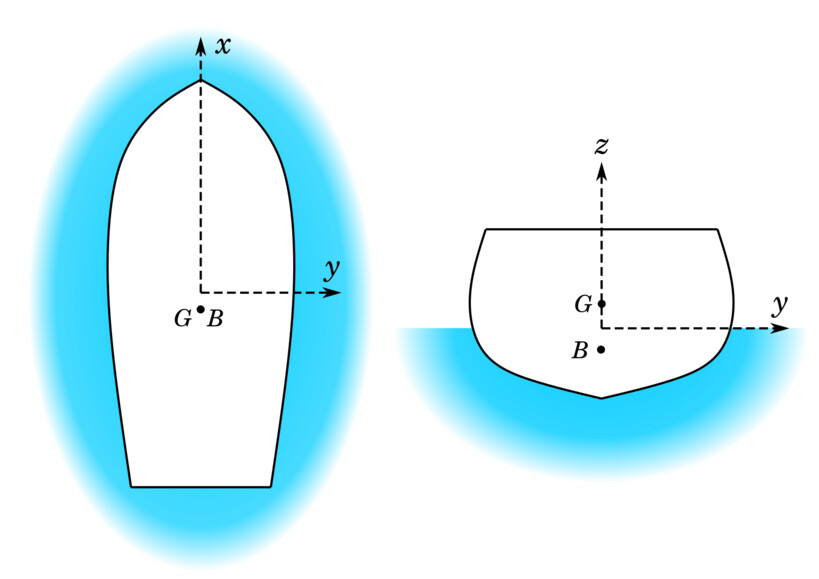Categories: Fluid mechanics, Physics.
Metacentric height
Consider an object with center of mass , floating in a large body of liquid whose surface is flat at . For our purposes, it is easiest to use a coordinate system whose origin is at the area centroid of the object’s cross-section through the liquid’s surface, namely:
Where is the cross-sectional area enclosed by the “waterline” around the “boat”. Note that the boat’s center of mass does not coincide with the origin in general, as is illustrated in the following sketch of our choice of coordinate system:
Here, is the center of buoyancy, equal to the center of mass of the volume of water displaced by the boat as per Archimedes’ principle. At equilibrium, the forces of buoyancy and gravity have equal magnitudes in opposite directions, and is directly above or below , or in other words, and , which are calculated as follows:
Where is the volume of the whole boat, and is the volume of liquid it displaces.
Whether a given equilibrium is stable is more complicated. Suppose the ship is tilted by a small angle around the -axis, in which case the old waterline, previously in the plane, gets shifted to a new plane, namely:
Then changes by , which is estimated below. If a point of the old waterline is raised by , then the displaced liquid underneath it is reduced proportionally, hence the sign:
So is unchanged, at least to first order in . However, the shape of the displaced volume may have changed significantly. Therefore, the shift of the position of the buoyancy center from to involves a correction in addition to the rotation by :
We find by calculating the virtual buoyancy center of the shape difference: on the side of the boat that has been lifted by the rotation, the center of buoyancy is “pushed” away due to the reduced displacement there, and vice versa on the other side. Consequently:
Where we have defined the so-called area moment of the waterline as follows:
Now that we have an expression for , the new center’s position is found to be:
This looks like a rotation by around a so-called metacenter , with a height known as the metacentric height, defined as:
Meanwhile, the position of is defined such that it lies on the line between the old centers and . Our calculation of has shown that the new always lies below .
After the rotation, the boat is not in equilibrium anymore, because the new is not directly above or below . The force of gravity then causes a torque given by:
Where points downwards. Since the rotation was around the -axis, we are only interested in the -component , which becomes:
With being a simple rotation of . At the initial equilibrium , so:
If , then has the same sign as , so further destabilizes the boat. But if , then counteracts the rotation, and the boat returns to the original equilibrium, leading us to the following stability condition:
In other words, for a given boat design (or general shape) and can be calculated, and as long as they satisfy the above inequality, it will float stably in water (or any other fluid, although the buoyancy depends significantly on the density).
References
- B. Lautrup, Physics of continuous matter: exotic and everyday phenomena in the macroscopic world, 2nd edition, CRC Press.
